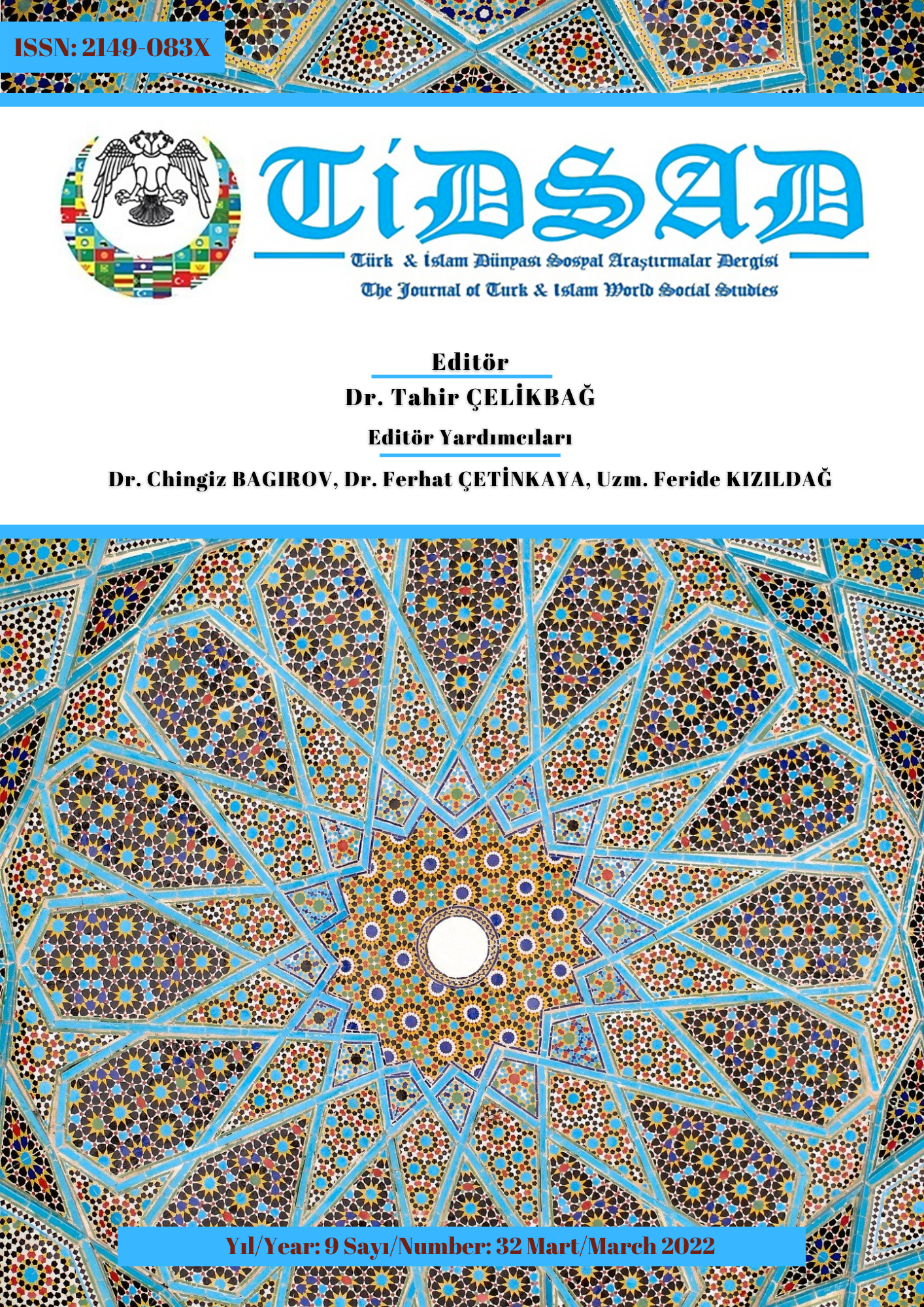H. 4. Yüzyıl’ın İlk Yarısında, Hadis Kaynaklarında Tasavvufun Ayak Sesleri: İbn Huzeyme ve İbn Hibban’ın Sahih’leri Özelinde
Author :
Abstract
Temel İslam bilimleri, bir elin beş parmağı gibi olup önemleri değişse de bir elin parmakları gibi olmaları değişmez. Her biri diğeriyle ilgili ve son derece geçirgendirler. Temel İslam Bilimlerinden birisi de hadis ilmidir. Hadis kitapları temelde, rivayet eden sahabî adına veya konularına göre sınıflandırılarak yazılmıştır. Bu iş, eş zamanlı olarak gerçekleşmiştir. Miladi 1000 yılı öncesinde yaşayan müelliflerimiz, fıkhu’l-hadisi ortaya koymak için yazdıkları ‘sahih’ adlı eserlerinde, hadis/ sünnet malzemesini kullanarak hayatın Müslümanca yaşanabilmesi adına, çözümler önermişlerdir. İbn Huzeyme, fıkıh bablarına göre te’lif ettiği eserinde emir, nehiy, ibâha, ruhsat vb. kavramları bab başlıklarında dile getirmiş; hadisin ilham ettiği hususu dile getirerek “mükellefi bağlayıcılığı açısından fıkhî hükümler” çıkarmıştır. İbn Huzeyme’den ipuçlarını yakaladığını düşündüğümüz İbn Hibban da hadis/ sünnetin bütününe “bağlayıcılık” açısından; fıkhî bir bakış açısıyla, “her habere bir başlık” atmıştır. Yaşadıkları dönemle ilgili olarak konu başlıklarında tasavvufla ilgili bazı bilgiler de vermişlerdir. Zühdün tasavvufa dönüşü, İslam’ın farklı coğrafyalara yayılmasıyla hızlanmıştır. İslam düşüncesi gittiği yerlere İslamî hayatı taşırken, İslamî hayata da bazı sızıntılar olmuştur. “Kolaylaştırın; zorlaştırmayın” sözü Yüce Allah Elçisi’nin (s.a.s.) koyduğu bir ilkedir. Ama bazı sufiler zorlaştırma yolunu seçmişlerdir. Bazı sufilerin dünya ve dünyalığa karşı soğuk davrandıkları sezilmektedir ancak bu durum toplum halinde yaşamak durumunda olan Müslümanların lehine olmamıştır. Nitekim zamanla slogan haline gelen “Bir lokma bir hırka” halkı Müslüman toplumlara büyük zararlar vermiştir. H. 4. Yüzyılın ilk yarısında, hadislerden fıkıh oluşturmaya çalışan bu iki müellifin eserlerinde sadece ‘mutasavvife’ anahtar kelimesinden hareket ettiğimizde, karşımıza çıkan metinler bunlardır. Hadis/ sünnetten seçtikleri malzemeleri işlerken zaman zaman bazı tasavvuf erbabının yapıkları yanlışlara hadis /sünnetten somut örnekler vermişlerdir.
Keywords
Abstract
‘Basic Islamic Sciences’ are like the five fingers of a hand and although their importance may change, their being like the fingers of a hand does not change. Each of they are related to the other and extremely permeable. One of the basic Islamic sciences is the science of Hadith. Basically the hadith books were written by classifying them according to the name of the narrator or their subject. This work took place simultaneously. Our authors, who lived before the year 1000 B.C, in their works called ‘sahih’, which they wrote to reveal the fiqh’l-hadith, suggested solutions for the purpose of living life as a Muslim by using the material of hadith/sunna. Ibn Huzeyme, in his copyrighted work according to the fiqh chapters, includes orders, prohibitions, ibaha, license, etc. expressed the concepts in the chapter titles; expressing the issue inspired by the hadith, he issued ‘fiqh rules in terms of binding the taxpayer’. Ibn Hibban, who we think caught the clues from Ibn Huzeyme, in terms of ‘binding’ to the whole hadith/sunna; from a fiqh point of view, he gave ‘a headline to every news’. They also gave some information about Sufism in the titles of the period in which they lived. The return of Zuhd to Sufism accelerated with the spread of Islam to different geographies. While the thought of Islam carried the Islamic life to the places it went, there were some leaks to the Islamic life. ‘Make it easy; do not make it difficult’ is a principle set up by the Messenger of Allah (s.a.s). But some Sufis chose to make it difficult. It is perceived that some Sufis behaved coldly towards the world and the worldly goods, but this situation did not favor the Muslims who had to live in society. As a matter of fact, which became a slogan in time, ‘One bite, one cardigan’, caused great harm to the people of Muslim societies. In the first half of the 4th century hijri, these are the texts we come across when we consider only the keyword 'sufi' in the works of these two authors who tried to create fiqh from hadiths. While processing the materials they chose from hadith/sunnah, they gave concrete examples from hadith/sunnah of the mistakes made by some Sufi connoisseurs from time to time.
Keywords
- Ebu Ubeyd, Kasım (1986). el-Hutab ve’l-Mevaiz, Kahire: Mektebetü’s-Sekafeti’d-Diniyye.
- Ebû Davud, Süleyman, (1993), Kitâbü'z-zühd, Kahire: Dârü'l-Mişkat.
- Işık, Mustafa. (1997). İbn Huzeyme, Sahih’i ve İbn Hibbân’ın Sahih’iyle Mukayesesi, Erci- yes Üniversitesi.
- İbn Hanbel, Ahmed, (1999). Kitabü’z-zühd, Beyrut: Daru’l-Kütübi’l-İlmiyye.
- İbn Hibbân, Muhammed, (2012). el-Müsnedu’s Sahîh ale’t-Tekâsîm ve’l-Enva’, Beyrut: Daru İbn Hazm.
- İbn Huzeyme, Muhammed (1992). Sahihu İbn Huzeyme, Beyrut: Mektebetü’l-İslamî.
- İbn Mâce, Muhammed, (1992). es-Sünen, İstanbul: Çağrı.
- Kettânî, Muhammed, (1986). er-Risaletu’l-Mustadrefe, Beyrut: Daru’l-Beşairi’l-İslamiyye.
- Kettanî, Muhammed, (1990). Hz. Peygamberin Yönetimi = (et-Teratîbü’l İdariyye), İstan- bul: İz yayıncılık.
- Serrâc, Ebû Nasr et-Tûsî, (1960). el-Lüma', thk. A. Mahmûd Tâhâ -Abdülbâkî Sürûr, Bağ- dâd: Dâru’l-kütübi’l-hadîse.
- Sem’ânî, Abdulkerim, (1988). el-Ensab, Beyrut: Daru’l-Cinan.
- Özçelik, Mevlüt, (2021). “Ebû Nâsr Serrâc’ın (ö. 378/988), Dönemindeki Bazı Tasavvufî Akımlara Yönelttiği Eleştiriler”, İslam Düşüncesinde Eleştiri Kültürü ve Tahammül Ahlâkı II (Klasik Dönem - M. VII. - XII. Yüzyıllar) İstanbul: Ensar Yay.
- Taberânî, Süleyman, (1978). Mu’cemu’l-Kebîr, Irak.
- Tayâlisî, Ebu Davud, (1999). Müsned, Mısır: Dâru Hecer.
- Telkenaroğlu, M. Rahmi, (2009). Fıkhu’l-Evleviyyât’ın (Öncelikler Fıkhı) Kaynakları ve Kuralları, Marife: Dini Araştırmalar Dergisi. cilt: IX, sayı, 1.
- Yıldırım, Ahmet, (2019). “Tasavvufta Tenkit Kültürü”, İslâm Düşüncesinde Eleştiri Kültü- rü ve Tahammül Ahlâkı -II-, ed. Mahsum Aytepe–Teceli Karasu, İstanbul: Ensar Yay.





